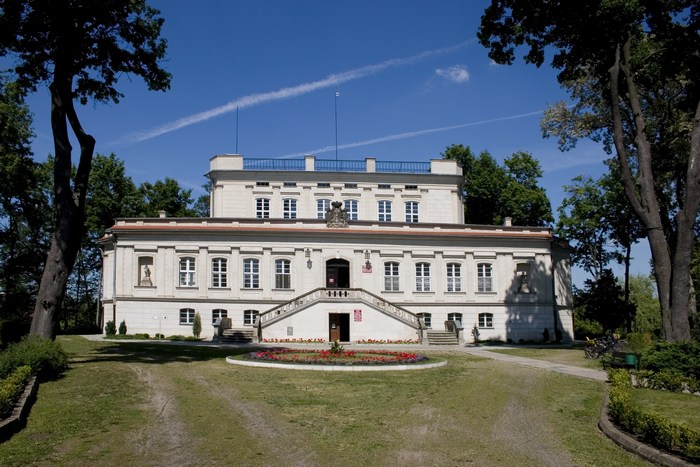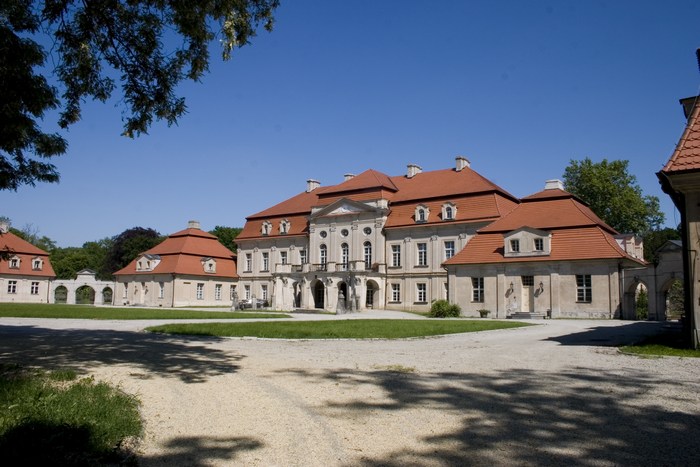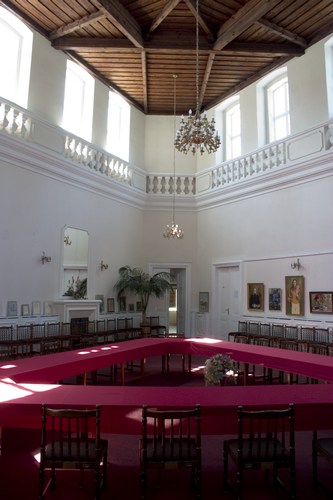
Włoszakowice is a village in the Leszno district (powiat), located ca. 20 km north-west of Leszno, ca. 30 km south-west of Kościan.
In the early 15th century, Włoszakowice was property of the knightly family of Borek Gryżyński who have erected a castle there. In 1481, the village was acquired by the Opalińskis who then remained the owners till the end of 18th century. A new, now not surviving, manor house was built probably in the former half of 17th c.
An enormous fortune was inherited after the last of the Opaliński line by his daughter Katarzyna who contributed it as a dowry to Stanisław Leszczyński, later to be King of Poland. In the time of his war for the throne against Augustus II the Strong (1704–1706), the Leszczyński’s estates in Wielkopolska were ravaged and eventually taken over by the Saxon-dynasty administration.
1738 saw acquisition of the property by Aleksander-Józef Sułkowski, a Roman duke, Court Master-of-the Hunt to the King, the prime minister with the court cabinet. His main residence was Rydzyna; he chose Włoszakowice as the site for his hunting palace, set up there in mid-18th century.
The palace was located at the former castle venue, on an artificial isle surrounded by moats, and was made part of the composition of a park which was then established. The building, novel as to its form, founded upon an equilateral-triangle projection with semicircular indented angles, has not survived to date as it lacks the cupola above its central section.
The building is made of bricks and plastered. It has a two-storied lower part covered with pent-roofs hidden behind an attic balustrade and an elevated central section protruding above it, formerly crowned with a cupola and, at present, also with a balustrade.
The symmetrically composed elevations have been designed in an identical fashion, with extra embellishments of the front which faces south-west.
The front elevation’s middle axis, containing the main entrance, is preceded with grand two-flight stairs furnished with a stone balustrade, leading to a piano nobile level.
A coat-of-arms cartouche, carved in stone, is placed above the main entrance. Some time ago, sculptures were placed at angle recesses – with two putti, displaying attributes referring to Aleksander Sułkowski’s military activities, surviving to this day.
The palace’s interior spatial composition – including the triangular two-level central room and an assembly of rooms surrounding it in a one-track arrangement – is integrally associated with the edifice’s shape and original function. Nothing has been saved from the former decor or furnishings, save for a somewhat mysterious arrangement of the walls of the ground-floor-storey central room, shaped into a rocky grotto whose irregular boulders feature elements of vegetal (incl. grapevine-motif) and animal decoration, along with architectural elements. Existence of this grotto, ascribed to Mr. Sułkowski’s activity as a freemason, has caused that a triangular shape of the palace’s solid, evoking the association with the trowel – a freemasonry symbol, was sometimes explained in terms of the proprietor’s membership of a Masonic lodge.
Yet, the palace was for most part shaped in accordance with the natural features of its surrounding area, the shape of the isle or the mediaeval building – and, in the first place, following the artistic invention of its architect who was probably associated with the Warsaw-Dresden milieu.
Aleksander-Józef Sułkowski died in 1762, bequeathing his magnate fortune to his four sons. The Włoszakowice estate was passed on to Franciszek, considered a spendthrift and troublemaker.
He settled down at Włoszakowice for good and surrounded himself with a magnificent court there. For some time, he maintained a court theatre and music ensemble.
The proprietor’s financial indebtedness eventually led to the estate’s sale in 1782. On initiative of Prince Leopold von Anhalt-Dessau, one of its owners then on, the copula crowning the building’s central section was dismantled (before 1848) and replaced with a flat roof hidden behind an attic whose form was that of an openwork balustrade. In 1923, the Włoszakowice estate, together with its buildings and other developments, were bought out by the State Treasury.
At present, a communal office is housed at the palace building.
The park near the palace contains Wielkopolska’s oldest plane tree, with an estimated age of above 500 years.
The Communal Office of Włoszakowice
ul. Kurpińskiego 29
64-140 Włoszakowice
Tel. +48 65 525 29 99
For more, read at:
www.wloszakowice.pl






